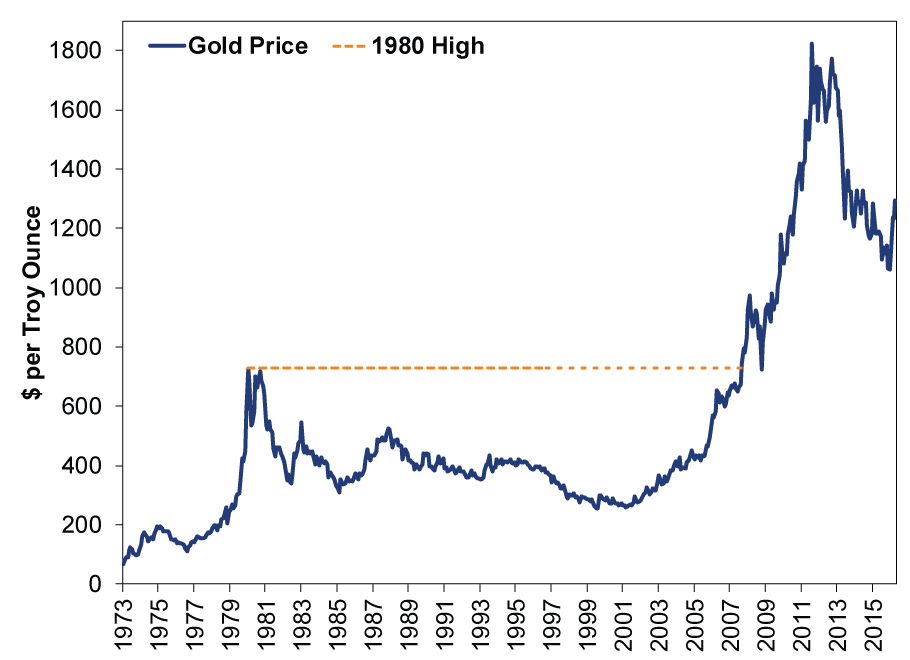Personal Wealth Management / Market Analysis
There Is Nothing Inherently Special About Gold
Gold is just a commodity, and a volatile one at that.
Gold has taken a breather from its 2016 rally this month, yet enthusiasm for the shiny yellow metal remains high-especially now that no lesser than George Soros has piled in. He is far from the only one. With the political uncertainty up and money pouring into gold ETFs, many believe the conditions are ripe for gold to run on and on.
But it's all myth. Gold isn't an inflation hedge, bulwark against low interest rates or a safe haven in troubled times. If you bought gold to hedge against inflation at pretty much any point in the 1980s or 1990s, it took years to pay off. Gold has also fallen during equity bear markets and periods of geopolitical turmoil, shattering that safety blanket myth. As an investment, gold has no special qualities. It is just a commodity, and a super volatile one. Its long-term returns trail stocks, yet its short-term returns are far more variable. Long-term gains, theoretically, are your compensation for enduring short-term ups and downs. Stocks deliver on this, but gold largely doesn't.
Long term, gold has little utility in a diverse portfolio. Investing successfully in gold requires near-perfect market timing. As Exhibit 1 shows, gold isn't a very viable long-term investment-with most of its positivity coming in short bursts. After one such burst in the late 1970s and early 1980, gold fell drastically and took 27 years to get back to the pre-drop high. During that span of time, the S&P 500 rose 2,861.7%, a wee bit of opportunity cost for gold holders.[i] Gold posted positive returns in 272 of 498 rolling 12-month periods since 1973, or a 54.6% frequency of positivity.[ii] Stocks rose in 398 of the same 498 rolling 12-month periods-a 79.9% frequency of positivity, crushing gold.[iii] Moreover, fully 132 of gold's positive 12-month rolling periods came in the 11 years from 2001 - 2012. The hot streak in recent years (before the big gold bust) is probably why so many folks talk up gold these days, but recency doesn't equal repeatability.
Exhibit 1: Gold Is More Bust Than Boom

Source: Global Financial Data, as of 5/4/2016. Gold Bullion Price - New York (US$/Troy Ounce), monthly, November 1973 - April 2016.
Stocks and gold move in cycles, but stocks' cycles are easier to forecast and navigate. Equity bull markets are much longer, overall and on average, than gold's booms. The gold booms in Exhibit 1 range from 4 to 34 months. Stock bull markets, by contrast, have ranged from 26 to 113 months since 1926. This bull market is seven years and counting and looks set to run for the foreseeable future, as sentiment remains well behind the growing global economy. Plus, stocks move on supply and demand fundamentals. Bull markets generally run on until sentiment overheats and investors ignore signs of a deteriorating economy and rising risk of recession, or until a huge and broadly unseen negative wallops global GDP to the tune of a few trillion dollars.
Gold moves on supply and demand, too, but sentiment is the swing factor, which is why navigating gold is far more difficult. Gold has very few industrial uses, and jewelry demand isn't huge. Headlines often obsess over central banks' gold purchases and sales, but these aren't outsized drivers. If they were, a huge gold rally probably wouldn't have followed the UK's infamous gold dump in the early 2000s. The bulk of gold demand thus comes from investors, driven by their emotions. Sentiment swings are impossible to predict and time. If they weren't, market history would be full of legendary investors who timed corrections repeatedly, selling at the peaks and buying back at the lows. But no one, as far as we're aware, has made their name this way or otherwise demonstrated repeated success at short-term timing.
Numerous studies and data sets like ETF and mutual fund flows show investors are poor market-timers. When volatility strikes, people regularly sell after stocks have fallen, then get back in after the recovery is underway, locking in losses and missing returns. So it goes with gold, too. Humans are hard wired to react to what has just happened and believe the future will resemble the recent past. That's why everyone is so hog wild for gold now. And hey, gold might keep rising! But it also might not. Sentiment is fickle, and commodities broadly remain locked in a downturn, with supply growth far outpacing demand growth. Gold production is still rising, and as long as that continues, it will take an extraordinary feat of sentiment to sustain gold's rally.
In our view, gold simply has no place in a long-term portfolio. Timing short-term swings in a volatile commodity is the antithesis of a long-term growth strategy.
If you would like to contact the editors responsible for this article, please message MarketMinder directly.
*The content contained in this article represents only the opinions and viewpoints of the Fisher Investments editorial staff.
Get a weekly roundup of our market insights
Sign up for our weekly e-mail newsletter.

You Imagine Your Future. We Help You Get There.
Are you ready to start your journey to a better financial future?

Where Might the Market Go Next?
Confidently tackle the market’s ups and downs with independent research and analysis that tells you where we think stocks are headed—and why.





